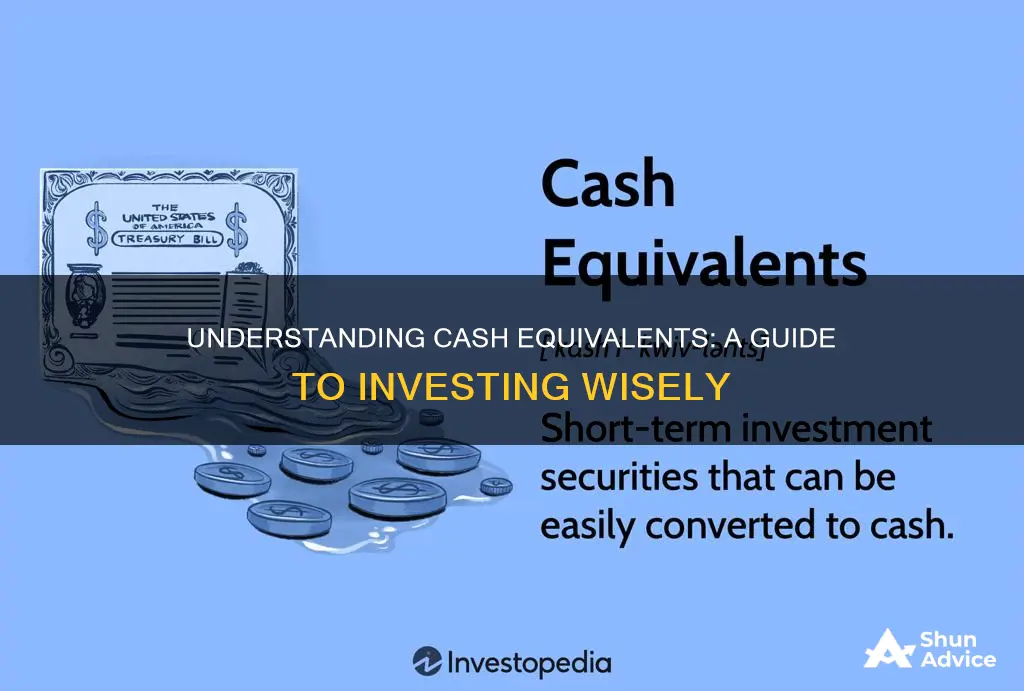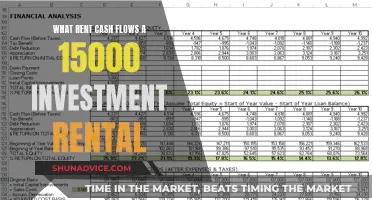
Cash equivalents are short-term investments that are highly liquid and can be readily converted into cash. They are usually low-risk and low-return, and are often used by companies to meet short-term obligations, build emergency funds, and prepare for future projects. Examples of cash equivalents include bank certificates of deposit, treasury bills, commercial paper, marketable securities, money market funds, short-term government bonds, and banker's acceptances. When deciding how to invest in cash equivalents, it is important to consider factors such as liquidity, safety, flexibility, passive income, capital preservation, and potential limitations on growth.
| Characteristics | Values |
|---|---|
| Liquidity | Very high |
| Convertible to cash | Yes |
| Maturity period | 3 months or less |
| Risk | Low |
| Return | Low |
| Accessibility | Unrestricted |
| Investment type | Short-term |
| Examples | US Treasury bills, bank certificates of deposit, commercial paper, money market funds, short-term government bonds, banker's acceptances |
What You'll Learn

Money market funds
There are different types of money market funds:
- Prime Money Funds: These funds invest in high-quality, short-term money market securities issued by US and foreign entities, including corporations, financial institutions, and the US government.
- Government and Treasury Money Funds: These funds invest in short-term US government debt securities, including US Treasury obligations and repurchase agreements.
- Municipal Money Funds: These funds invest in short-term municipal money market securities issued by states, local governments, and other municipal agencies.
Dividends: Cash Flow from Investing?
You may want to see also

Short-term government bonds
Compared to other investments, short-term government bonds generally offer lower returns. They may not be suitable for long-term investment goals due to their limited growth potential and the risk of decreasing purchasing power over time because of inflation.
Investing Wisely: Understanding Cash Flow & Depreciation
You may want to see also

Marketable securities
Companies may elect to classify some types of marketable securities as cash equivalents, depending on the liquidity of the investment and the company's intentions. For example, a three-month US Treasury bill is a marketable security that can also be classified as a cash equivalent.
The liquidity of marketable securities is driven by investor demand and market conditions. When a security is in high demand, its liquidity often increases, creating a virtuous cycle where higher demand leads to more frequent trading, attracting more market participants. However, marketability does not equate to profitability, and even liquid assets can become harder to sell without accepting a substantial discount during times of market stress.
Restricted Cash: A Viable Investment Option?
You may want to see also

Certificates of deposit
CDs are a safer and more conservative investment than stocks and bonds, but offer a lower opportunity for growth. They are also insured by the Federal Deposit Insurance Corporation (FDIC) or the National Credit Union Administration (NCUA). In both cases, up to $250,000 of your funds are protected in the rare event that the institution fails.
CDs come in a variety of terms, from 3-, 6-, or 12-months to 4-, 5-, and even 10-year terms. The shortest CD term is usually three months, and the longest is five years. Generally, the longer the term, the higher the rate the CD pays.
CDs are available at most banks and credit unions, and you can also open them through your brokerage account. Most local and national banks issue CDs, although you can often get a higher interest rate from an online bank.
When opening a CD, you will need to consider the interest rate, term, principal, and financial institution. The interest rate is usually fixed, although there are variable-rate CDs that could earn a higher return if rates rise. The term is the length of time that you agree to leave your funds deposited to avoid any penalty. The principal is the amount that you agree to deposit when you open the CD. The financial institution will set factors such as early withdrawal penalties (EWPs) and whether your CD will default to being automatically reinvested at maturity.
CDs are a good option if you have cash that you don't need now but will want within a few years. They are also a good choice if you want a more conservative investment with lower risk and volatility than stocks and bonds. One downside of CDs is that your money is locked into the investment, which can be beneficial for savers who want to avoid the temptation of withdrawing from their savings.
Strategies for Investing Cash Reserves: A Guide to Opportunities
You may want to see also

Commercial paper
Cash equivalents are important because they are an indicator of a company's financial health and stability. They are also one of the three main asset classes in investing, the other two being stocks and bonds.
Pension Plans: Cash, Investments, and Your Retirement Future
You may want to see also
Frequently asked questions
Cash equivalents are short-term, highly liquid investments that can be readily converted into known amounts of cash. They are usually low-risk and have a maturity period of 90 days or less. Examples include US Treasury bills, bank certificates of deposit, and commercial paper.
Cash equivalents provide a buffer against fluctuations in the value of more volatile assets, such as stocks. They also offer a modest return on investment, flexibility to meet short-term obligations, and easy access to funds in the case of emergencies.
The main types of cash equivalents include certificates of deposit, US Treasury bills, bank money market accounts, and money market mutual funds. Some offer greater liquidity, while others pay higher interest rates. It's important to consider your financial goals and time horizon when deciding which type of cash equivalent to invest in.
While cash equivalents are generally considered low-risk, they are still subject to market fluctuations and the risk of default by the issuing entity. Additionally, they may not offer significant growth potential and can limit the potential for higher returns elsewhere.







